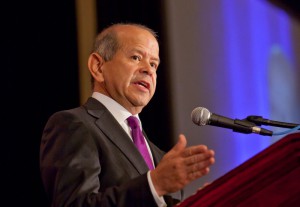
In a positive address which noted the progress that the FAA and industry have made towards drone integration by working together, Huerta spoke of his legacy at the FAA. “I sincerely hope that when my term as FAA Administrator ends in January,” said Huerta, “that the word-cloud of my most-used terms will include those words: collaboration, innovation and safety.”
The Administrator emphasized the speed in which the drone industry has developed, and the rapidly changing issues that regulators face. “In just a few short years, the unmanned aircraft community has evolved into a vibrant industry,” he commented. “It’s an incubator for ideas that are changing the way the world thinks about flying.”
“It wasn’t that long ago that we were talking about how drones might be used for aerial photography or package delivery…Now, we’re having very intense and very real conversations about a day in the not-that-distant future when a drone taxi might lift you above the rush-hour traffic in a dense metropolitan area and make sure you get to that meeting across town on time.”
Huerta addressed the issue of ever growing state and local drone regulations, a major problem for the commercial industry that struggles to comply with multiple sets of rules. “…the unprecedented rate at which unmanned aircraft are evolving means we have to grapple with new and complex questions that affect a broad spectrum of the many stakeholders that we have in this industry,” said Huerta. “This is particularly apparent as we consider the roles of government, the roles of federal government, state and local governments, and how they should play in this space….”
“Now, as FAA Administrator, I have a very clear sense of what the existing FAA authorities are, and our processes to ensure their compliance and to enforce the rules…But I think you would all agree we need greater clarity as to what state and local governments would like to see, and the role that they would like to play.”
Saying that the Drone Advisory Committee was working on the issue, Huerta hoped to reveal a “concept they’ve been working with” to deal with the issue in the near future. Additionally, the Administrator noted that work on regularizing flight over people was moving forward, with the recent publication of research on the subject, and that the results of another study about the potential effects of a drone colliding with an aircraft would be released later this summer.
Huerta mentioned security concerns, saying that the FAA was working with law enforcement and the military to address them – focusing on drone detection technology. “In late April, the FAA and our partners completed the fifth and final field evaluation of possible drone detection systems just down the road at Dallas/Fort Worth International Airport,” Huerta reported. “This most recent evaluation used a combination of technologies, including radar, radio frequency and electro-optical systems. We plan to use the information we’ve received from this test, the test in Denver, and elsewhere, and other information, to develop minimum performance standards for any unmanned aircraft detection technology that might be deployed around airports here in the United States.”
A new Aviation Rulemaking Committee, designed to help create standards for remotely identifying and tracking unmanned aircraft during operations, was also announced.
Throughout the speech, Huerta focused on safety, saying that “safety shouldn’t rely on luck. Safety needs to be intentional.” While emphasizing the importance of education and compliance with regulations, Huerta said that industry innovation would play a key role in safety: “…the real advancements in safety have come through technology,” he commented.”…Someday, one of you will invent an unmanned aircraft that will be incapable of colliding with anything, whether it’s a tree, a building, a person, or an aircraft moving at several hundred miles an hour.”
The Administrator closed his speech by thanking the industry for their work on safe drone integration. “I know that this industry will continue to rise to that challenge,” said Huerta. “I thank you for what you’re doing each and every day to harness innovation and to make this a great and safe place to fly.”
Miriam McNabb is the Editor-in-Chief of DRONELIFE and CEO of JobForDrones, a professional drone services marketplace, and a fascinated observer of the emerging drone industry and the regulatory environment for drones. Miriam has penned over 3,000 articles focused on the commercial drone space and is an international speaker and recognized figure in the industry. Miriam has a degree from the University of Chicago and over 20 years of experience in high tech sales and marketing for new technologies.
For drone industry consulting or writing, Email Miriam.
TWITTER:@spaldingbarker
Subscribe to DroneLife here.